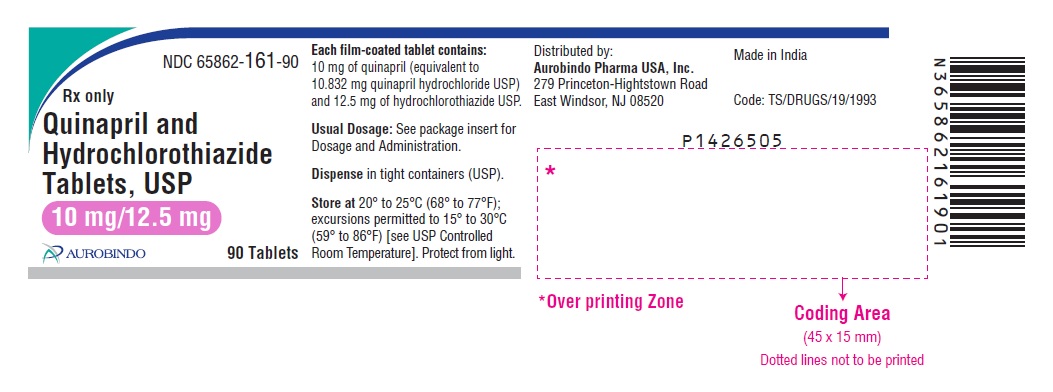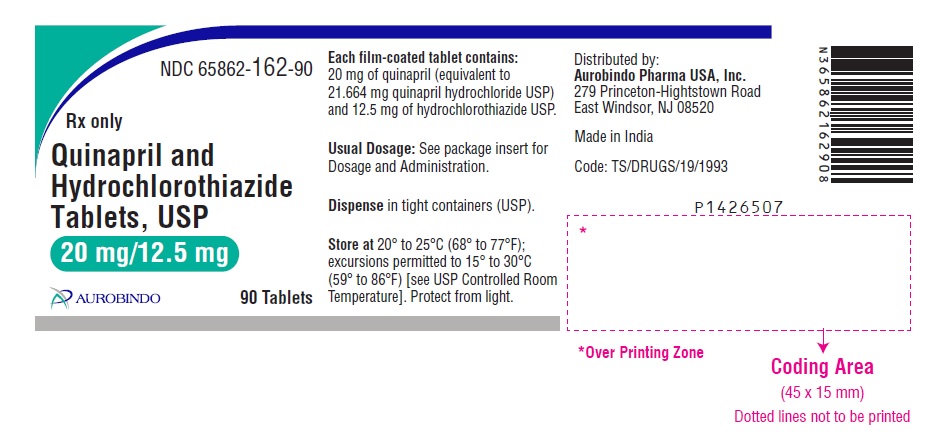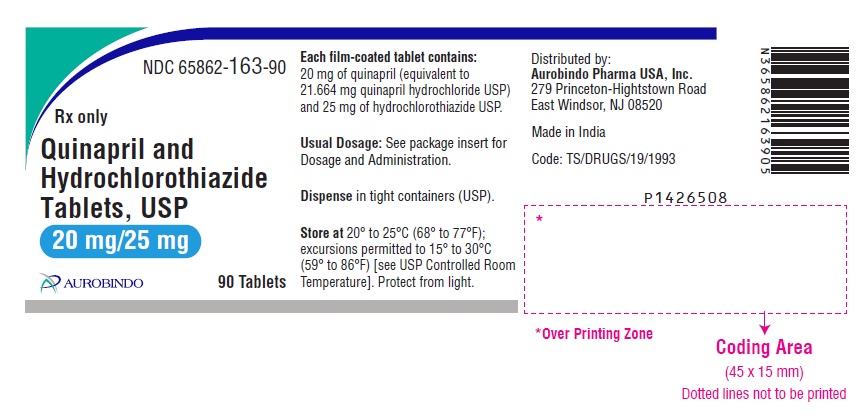Drug Catalog - Product Detail
QUINAPRIL HCL/ HCTZ TB 10/12.5MG 90
| NDC | Mfr | Size | Str | Form |
|---|---|---|---|---|
| 65862-0161-90 | AUROBINDO PHARMA | 90 | 10-12.5MG | TABLET |
PACKAGE FILES





Generic Name
QUINAPRIL HYDROCHLORIDE/HYDROCHLOROTHIAZIDE
Substance Name
HYDROCHLOROTHIAZIDE
Product Type
HUMAN PRESCRIPTION DRUG
Route
ORAL
Application Number
ANDA078450
Description
DESCRIPTION Quinapril and hydrochlorothiazide tablets, USP are fixed-combination tablet that combines an angiotensin-converting enzyme (ACE) inhibitor, quinapril hydrochloride, and a thiazide diuretic, hydrochlorothiazide. Quinapril hydrochloride is chemically described as [3S-[2[R*(R*)], 3R*]]-2-[2-[[1-(ethoxycarbonyl)-3-phenylpropyl]amino]-1-oxopropyl]-1,2,3,4-tetrahydro-3-isoquinolinecarboxylic acid, monohydrochloride. Its molecular formula is C 25 H 30 N 2 O 5 . HCl and its structural formula is: Quinapril hydrochloride USP is a white to off-white amorphous powder that is freely soluble in aqueous solvents. Hydrochlorothiazide is chemically described as: 6-Chloro-3,4-dihydro-2H-1,2,4-benzothiadiazine-7-sulfonamide 1,1-dioxide. Its molecular formula is C 7 H 8 ClN 3 O 4 S 2 and its structural formula is: Hydrochlorothiazide USP is a white to off-white, crystalline powder which is slightly soluble in water but freely soluble in sodium hydroxide solution. Quinapril and hydrochlorothiazide tablets, USP are available for oral use as fixed combination tablets in three strengths of quinapril with hydrochlorothiazide: 10 mg (equivalent to 10.832 mg quinapril hydrochloride USP) with 12.5 mg (quinapril and hydrochlorothiazide 10/12.5), 20 mg (equivalent to 21.664 mg quinapril hydrochloride USP) with 12.5 mg (quinapril and hydrochlorothiazide 20/12.5), and 20 mg (equivalent to 21.664 mg quinapril hydrochloride USP) with 25 mg (quinapril and hydrochlorothiazide 20/25). The strength of the quinapril hydrochloride component is in terms of quinapril. Inactive ingredients: lactose monohydrate, magnesium carbonate, crospovidone, povidone, magnesium stearate, hypromellose, hydroxypropyl cellulose, polyethylene glycol 400, titanium dioxide, iron oxide red and iron oxide yellow. Quinapril Hydrochloride Chemical Structure Hydrochlorothiazide Chemical Structure
How Supplied
HOW SUPPLIED Quinapril and Hydrochlorothiazide Tablets, USP 10 mg/12.5 mg are Pink colored, scored, oval shaped, biconvex, film-coated tablets debossed with ‘D’ on scored side and ‘18’ on other side. Bottles of 90 NDC 65862-161-90 Quinapril and Hydrochlorothiazide Tablets, USP 20 mg/12.5 mg are Pink colored, scored, round shaped, biconvex, film-coated tablets debossed with ‘D’ on scored side and ‘19’ on other side. Bottles of 30 NDC 65862-162-30 Bottles of 90 NDC 65862-162-90 Quinapril and Hydrochlorothiazide Tablets, USP 20 mg/25 mg are Pink colored, round shaped, biconvex, film-coated tablets debossed with ‘D’ on one side and ‘20’ on other side. Bottles of 90 NDC 65862-163-90 Store at 20° to 25°C (68° to 77°F); excursions permitted to 15° to 30°C (59° to 86°F) [see USP Controlled Room Temperature]. Protect from light. Distributed by: Aurobindo Pharma USA, Inc. 279 Princeton-Hightstown Road East Windsor, NJ 08520 Manufactured by: Aurobindo Pharma Limited Hyderabad–500 032, India Revised: 05/2022
Indications & Usage
INDICATIONS AND USAGE Hypertension Quinapril and hydrochlorothiazide tablets are indicated for the treatment of hypertension, to lower blood pressure. Lowering blood pressure reduces the risk of fatal and nonfatal cardiovascular events, primarily strokes and myocardial infarctions. These benefits have been seen in controlled trials of antihypertensive drugs from a wide variety of pharmacologic classes including the class to which this drug principally belongs. There are no controlled trials demonstrating risk reduction with quinapril and hydrochlorothiazide tablets. Control of high blood pressure should be part of comprehensive cardiovascular risk management, including, as appropriate, lipid control, diabetes management, antithrombotic therapy, smoking cessation, exercise, and limited sodium intake. Many patients will require more than one drug to achieve blood pressure goals. For specific advice on goals and management, see published guidelines, such as those of the National High Blood Pressure Education Program’s Joint National Committee on Prevention, Detection, Evaluation, and Treatment of High Blood Pressure (JNC). Numerous antihypertensive drugs, from a variety of pharmacologic classes and with different mechanisms of action, have been shown in randomized controlled trials to reduce cardiovascular morbidity and mortality, and it can be concluded that it is blood pressure reduction, and not some other pharmacologic property of the drugs, that is largely responsible for those benefits. The largest and most consistent cardiovascular outcome benefit has been a reduction in the risk of stroke, but reductions in myocardial infarction and cardiovascular mortality also have been seen regularly. Elevated systolic or diastolic pressure causes increased cardiovascular risk, and the absolute risk increase per mmHg is greater at higher blood pressures, so that even modest reductions of severe hypertension can provide substantial benefit. Relative risk reduction from blood pressure reduction is similar across populations with varying absolute risk, so the absolute benefit is greater in patients who are at higher risk independent of their hypertension (for example, patients with diabetes or hyperlipidemia), and such patients would be expected to benefit from more aggressive treatment to a lower blood pressure goal. Some antihypertensive drugs have smaller blood pressure effects (as monotherapy) in black patients, and many antihypertensive drugs have additional approved indications and effects (e.g., on angina, heart failure, or diabetic kidney disease). These considerations may guide selection of therapy. This fixed combination is not indicated for the initial therapy of hypertension (see DOSAGE AND ADMINISTRATION ). In using quinapril and hydrochlorothiazide tablets, consideration should be given to the fact that another angiotensin-converting enzyme inhibitor, captopril, has caused agranulocytosis, particularly in patients with renal impairment or collagen-vascular disease. Available data are insufficient to show that quinapril does not have a similar risk (see WARNINGS: Neutropenia/Agranulocytosis ). Angioedema in Black Patients Black patients receiving ACE inhibitor monotherapy have been reported to have a higher incidence of angioedema compared to non-blacks. It should also be noted that in controlled clinical trials, ACE inhibitors have an effect on blood pressure that is less in black patients than in non-blacks.
Dosage and Administration
DOSAGE AND ADMINISTRATION As individual monotherapy, quinapril is an effective treatment of hypertension in once-daily doses of 10 mg to 80 mg and hydrochlorothiazide is effective in doses of 12.5 mg to 50 mg. In clinical trials of quinapril/hydrochlorothiazide combination therapy using quinapril doses of 2.5 mg to 40 mg and hydrochlorothiazide doses of 6.25 mg to 25 mg, the antihypertensive effects increased with increasing dose of either component. The side effects (see WARNINGS ) of quinapril are generally rare and apparently independent of dose; those of hydrochlorothiazide are a mixture of dose-dependent phenomena (primarily hypokalemia) and dose-independent phenomena (e.g., pancreatitis), the former much more common than the latter. Therapy with any combination of quinapril and hydrochlorothiazide will be associated with both sets of dose-independent side effects, but regimens that combine low doses of hydrochlorothiazide with quinapril produce minimal effects on serum potassium. In clinical trials of quinapril and hydrochlorothiazide tablets, the average change in serum potassium was near zero in subjects who received HCTZ 6.25 mg in the combination, and the average subject who received 10 mg to 40 mg/12.5 mg to 25 mg experienced a milder reduction in serum potassium than that experienced by the average subject receiving the same dose of hydrochlorothiazide monotherapy. To minimize dose-independent side effects, it is usually appropriate to begin combination therapy only after a patient has failed to achieve the desired effect with monotherapy. Therapy Guided by Clinical Effect Patients whose blood pressures are not adequately controlled with quinapril monotherapy may instead be given quinapril and hydrochlorothiazide tablets 10 mg/12.5 mg or 20 mg/12.5 mg. Further increases of either or both components could depend on clinical response. The hydrochlorothiazide dose should generally not be increased until 2 to 3 weeks have elapsed. Patients whose blood pressures are adequately controlled with 25 mg of daily hydrochlorothiazide, but who experience significant potassium loss with this regimen, may achieve blood pressure control with less electrolyte disturbance if they are switched to quinapril and hydrochlorothiazide tablets 10 mg/12.5 mg or 20 mg/12.5 mg. Replacement Therapy For convenience, patients who are adequately treated with 20 mg of quinapril and 25 mg of hydrochlorothiazide and experience no significant electrolyte disturbances may instead wish to receive quinapril and hydrochlorothiazide tablets 20 mg/25 mg. Use in Renal Impairment Regimens of therapy with quinapril and hydrochlorothiazide tablets need not take account of renal function as long as the patient’s creatinine clearance is >30 mL/min/1.73 m 2 (serum creatinine roughly ≤3 mg/dL or 265 µmol/L). In patients with more severe renal impairment, loop diuretics are preferred to thiazides. Therefore, quinapril and hydrochlorothiazide tablets are not recommended for use in these patients.
